
The Burgundians were an early Germanic tribe or group of tribes. They appeared in the middle Rhine region, near the Roman Empire, and were later moved into the empire, in the western Alps and eastern Gaul. They were possibly mentioned much earlier in the time of the Roman Empire as living in part of the region of Germania that is now part of Poland.
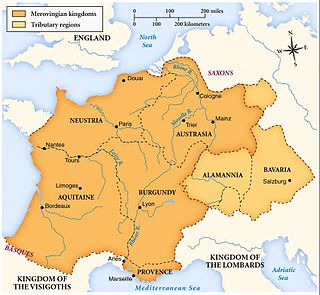
The Merovingian dynasty was the ruling family of the Franks from the middle of the 5th century until 751. They first appear as "Kings of the Franks" in the Roman army of northern Gaul. By 509 they had united all the Franks and northern Gaulish Romans under their rule. They conquered most of Gaul, defeating the Visigoths (507) and the Burgundians (534), and also extended their rule into Raetia (537). In Germania, the Alemanni, Bavarii and Saxons accepted their lordship. The Merovingian realm was the largest and most powerful of the states of western Europe following the breaking up of the empire of Theodoric the Great.

Clovis was the first king of the Franks to unite all of the Frankish tribes under one ruler, changing the form of leadership from a group of petty kings to rule by a single king and ensuring that the kingship was passed down to his heirs. He is considered to have been the founder of the Merovingian dynasty, which ruled the Frankish kingdom for the next two centuries.

Gregory of Tours was a Gallo-Roman historian and Bishop of Tours during the Merovingian period. He was considered a leading prelate in the Merovingian kingdom, which encompassed the historical region of Gaul.

Clotilde, also known as Clothilde, Clotilda, Clotild, Rotilde etc., was a Queen of All the Franks. She was supposedly descended from the Gothic king Athanaric and became the second wife of the Frankish king Clovis I in 493. The Merovingian dynasty to which her husband belonged ruled Frankish kingdoms for over 200 years (450–758).
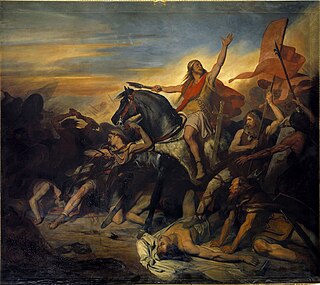
The Battle of Tolbiac was fought between the Franks, who were fighting under Clovis I, and the Alamanni, whose leader is not known. The date of the battle has traditionally been given as 496, though other accounts suggest it may either have been fought earlier, in the 480s or early 490s, or later, in 506. The site of "Tolbiac", or "Tolbiacum", is usually given as Zülpich, North Rhine-Westphalia, about 60 km east of what is now the German-Belgian frontier. The Franks were successful at Tolbiac and established their dominance over the Alamanni.

Gundobad was King of the Burgundians, succeeding his father Gundioc of Burgundy. Previous to this, he had been a patrician of the moribund Western Roman Empire in 472 – 473, three years before its collapse, succeeding his uncle Ricimer. He is perhaps best known today as the probable issuer of the Lex Burgundionum legal codes, which synthesized Roman law with ancient Germanic customs. He was the husband of Caretene.

Alcimus EcdiciusAvitus was a Latin poet and bishop of Vienne in Gaul. His fame rests in part on his poetry, but also on the role he played as secretary for the Burgundian kings.
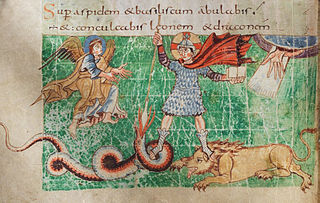
The Germanic peoples underwent gradual Christianization in the course of late antiquity and the Early Middle Ages. By AD 700, England and Francia were officially Christian, and by 1100 Germanic paganism had also ceased to have political influence in Scandinavia.

The Salian Franks, also called the Salians, were a northwestern subgroup of the early Franks who appear in the historical record in the fourth and fifth centuries. They lived west of the Lower Rhine in what was then the Roman Empire and today the Netherlands and Belgium.
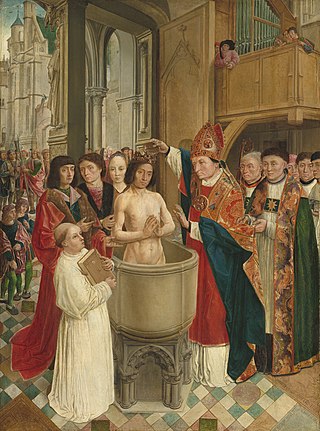
Remigius was the Bishop of Reims and "Apostle of the Franks". On 25 December 496, he baptised Clovis I, King of the Franks. The baptism, leading to about 3000 additional converts, was an important event in the Christianization of the Franks. Because of Clovis's efforts, a large number of churches were established in the formerly pagan lands of the Frankish empire, establishing a distinct Catholic variety of Christianity for the first time in Germanic lands, most of whom had been converted to Arian Christianity.

The Franks were a group of Germanic peoples whose name was first mentioned in 3rd-century Roman sources, and associated with tribes between the Lower Rhine and the Ems River, on the edge of the Roman Empire. Later the term was associated with Romanized Germanic dynasties within the collapsing Western Roman Empire, who eventually commanded the whole region between the rivers Loire and Rhine. They imposed power over many other post-Roman kingdoms and Germanic peoples. Beginning with Charlemagne in 800, Frankish rulers were given recognition by the Catholic Church as successors to the old rulers of the Western Roman Empire.

Liuvigild, Leuvigild, Leovigild, or Leovigildo, was a Visigothic King of Hispania and Septimania from 568 to 586. Known for his Codex Revisus or Code of Leovigild, a law allowing equal rights between the Visigothic and Hispano-Roman population, his kingdom covered modern Portugal and most of modern Spain down to Toledo. Liuvigild ranks among the greatest Visigothic kings of the Arian period.
The First Council of Orléans was convoked by Clovis I, King of the Franks, in 511. Clovis called for this synod four years after his victory over the Visigoths under Alaric II at the Battle of Vouillé in 507. The council was attended by thirty-two bishops, including four metropolitans, from across Gaul, and together they passed thirty-one decrees. The bishops met at Orléans to reform the church and construct a strong relationship between the crown and the Catholic episcopate, the majority of the canons reflecting compromise between these two institutions.
The pagan religion of the Germanic tribal confederation of the Franks has been traced from its roots in polytheistic Germanic paganism through to the incorporation of Greco-Roman components in the Early Middle Ages. This religion flourished among the Franks until the conversion of the Merovingian king Clovis I to Nicene Christianity, though there were many Frankish Christians before that. After Clovis I, Frankish paganism was gradually replaced by the process of Christianisation, but there were still pagans in the late 7th century.
Gaul was an important early center of Latin Christianity in late antiquity and the Merovingian period. By the middle of the 3rd century, there were several churches organized in Roman Gaul, and soon after the cessation of persecution the bishops of the Latin world assembled at Arles, in AD 314. The Church of Gaul passed through three dogmatic crises in the late Roman period, Arianism, Priscillianism and Pelagianism. Under Merovingian rule, a number of "Frankish synods" were held, marking a particularly Germanic development in the Western Church. A model for the following Frankish synods was set by Clovis I, who organized the First Council of Orléans (511).
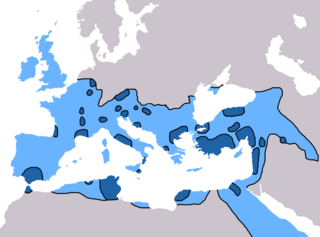
In the 5th century in Christianity, there were many developments which led to further fracturing of the State church of the Roman Empire. Emperor Theodosius II called two synods in Ephesus, one in 431 and one in 449, that addressed the teachings of Patriarch of Constantinople Nestorius and similar teachings. Nestorius had taught that Christ's divine and human nature were distinct persons, and hence Mary was the mother of Christ but not the mother of God. The Council rejected Nestorius' view causing many churches, centered on the School of Edessa, to a Nestorian break with the imperial church. Persecuted within the Roman Empire, many Nestorians fled to Persia and joined the Sassanid Church thereby making it a center of Nestorianism. By the end of the 5th century, the global Christian population was estimated at 10-11 million. In 451 the Council of Chalcedon was held to clarify the issue further. The council ultimately stated that Christ's divine and human nature were separate but both part of a single entity, a viewpoint rejected by many churches who called themselves miaphysites. The resulting schism created a communion of churches, including the Armenian, Syrian, and Egyptian churches, that is today known as Oriental Orthodoxy. In spite of these schisms, however, the imperial church still came to represent the majority of Christians within the Roman Empire.

In 6th-century Christianity, Roman Emperor Justinian launched a military campaign in Constantinople to reclaim the western provinces from the Germans, starting with North Africa and proceeding to Italy. Though he was temporarily successful in recapturing much of the western Mediterranean he destroyed the urban centers and permanently ruined the economies in much of the West. Rome and other cities were abandoned. In the coming centuries the Western Church, as virtually the only surviving Roman institution in the West, became the only remaining link to Greek culture and civilization.
Ingunde, Ingund, Ingundis or Ingunda, was the eldest child of Sigebert I, king of Austrasia, and his wife Brunhilda, daughter of King Athanagild of the Visigoths. She married Hermenegild and became the first Catholic queen of the Visigoths.
Lantechildis was a Frankish noblewoman, the daughter of the Frankish king Childeric I (d. 481) and the Thuringian noblewoman Basina (d. 477). She was a sister of Clovis I. She is mentioned in Gregory of Tours and the Liber historiae Francorum.















